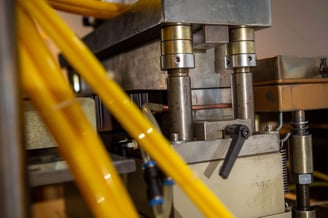Top 5 Anti-Static Packaging Solutions

Many industries, especially those that ship sensitive electronics, use anti-static packaging. As the name suggests, this type of packaging is made of one of several materials that prevent static charges from forming. Why is it necessary, though, and what are some of the options available to you? Keep reading to learn everything you need to know.
Why Is Anti-Static Packaging Necessary?
Anti-static packaging is important because it protects electronics from being damaged by static charges. Electronics, especially those with exposed metal parts like computer motherboards, are extremely susceptible to damage from static discharge. Even a small shock can create a strong enough arc to destroy circuits and render the device useless.
Conventional shipping materials like plastic wrap and styrofoam are, unfortunately, prone to creating static charges. Because of this, it is extremely risky to ship electronic components using these materials.
Instead, many manufacturers choose to ship their products with special anti-static materials. These materials often give the device being shipped protection from damage in transit as well as from a static shock. Here are a few of the top anti-static packaging materials in the industry.
1. Thermoformed Plastic Anti-Static Trays
In terms of cost, convenience, and durability, trays made from anti-static material plastic are some of the industry’s best. Keep in mind, though, that not all plastic trays are static-resistant. By itself, plastic tends to create a lot of static due to its poor conductivity. Specific types of plastic, though, resist electrostatic discharges, making them excellent for electronic shipping containers. Look for trays made of anti-static plastics, such as:
- PETG Anti-Static
- Conductive Styrene
- HDPE Blue Anti-Static
- HDPE Black Conductive
- Conductive ABS
- Anti-Static PVC
- ESD Polycarbonate
Each of these anti-static plastics have distinct traits that make them suitable for specific use cases. For example, some are designed to slough off static charges, while others are not. Each type of plastic varies in rigidity, so some may be suitable for longer shipping journeys than others. Ultimately, it comes down to what your needs are, what you plan to do with the plastic trays, and which materials best suit your needs.
Static resistance aside, thermoformed plastic trays make a great shipping material for many other reasons. Thermoformed plastic is extremely durable and is designed to be reused, meaning that you can invest in a set of long-lasting shipping materials rather than continuously paying for single-use packaging.
In addition, thermoformed plastic is cheap, customizable, and sustainable. Some manufacturers of thermoformed plastic trays use recycled materials and plastic scraps to create the trays, which reduces environmental impact and allows them to offer great prices to their clients.
Working with a manufacturer allows you to communicate your needs and customize the size, shape, material, and even color of your trays accordingly. This allows you to create the perfect product for your use case without the extremely high cost often associated with custom solutions.
2. Anti-Static Bags
Though thermoformed plastic trays are one of the best anti-static shipping materials, they are far from the only ones. If you plan to ship smaller, more delicate components, for example, anti-static bags might suit your needs. They feature a conductive layer that prevents static charges from forming and damaging the contents. With a relatively low price tag, they can serve as a strong budget option for many use cases.
Their main weakness, though, is their durability. Most anti-static bags are made of thin plastic. Many electronic components are, of course, sensitive to impacts, such as bumps in the road and other shocks associated with shipping, that a thin layer of plastic cannot protect against. To compensate, we recommend further packing the anti-static bags in a secure material that will absorb any impacts rather than leaving the bags to do the whole job.
That does not, however, solve the other issue that stems from their lack of durability: sustainability. Because anti-static bags are made of such thin material, they start to show wear and tear almost immediately. You will most likely not be able to reuse them, which makes them an unviable option for eco-friendly companies.
3. Anti-Static Packing Foam
Anti-static packing foam works in the same way as regular packing foam, but is much better at protecting sensitive electronic components. It is quite durable and can be reused a number of times before it has to be disposed of, making it a great choice for companies who want to sustainably ship electronics. The problem? Anti-static packing foam tends to be more expensive than many other materials, so it may not be within your company’s budget.
4. Anti-Static Void Fill Packaging
Anti-static void fill packaging resembles styrofoam packing peanuts, but unlike styrofoam, it doesn’t conduct any static electricity, so helps reduce the possibility of shorting out the components. The large number of soft pellets also protect sensitive electronic components from sudden jolts or impacts during transit, and do so for a fairly low price.
The problem, however, is that void fill packaging is not eco-friendly in any sense. Because the pellets are so lightweight, they can fly away easily during packing or unpacking. In most cases, they will not degrade naturally, so they will pollute whatever environment they happen to be in.
5. Shielding Film
Shielding film is similar to plastic wrap, albeit with the added benefit of protecting electronics from static discharge. It is effective in preventing static buildup and is quite affordable, but runs into many of the same disadvantages as anti-static plastic bags. If you plan to use shielding film, be sure to have some other protective packaging solution ready as well. If your company is aiming to be more environmentally friendly, we recommend avoiding it altogether.
Anti-Static Packaging Solutions From Ready Made
If you’d like to learn more about anti-static packaging solutions like thermoformed plastic trays, feel free to visit our website at Ready-Made today! We offer information on a wide variety of plastics for an even wider variety of uses, and can provide you with the perfect thermoformed plastic shipping solutions. Contact us today!



